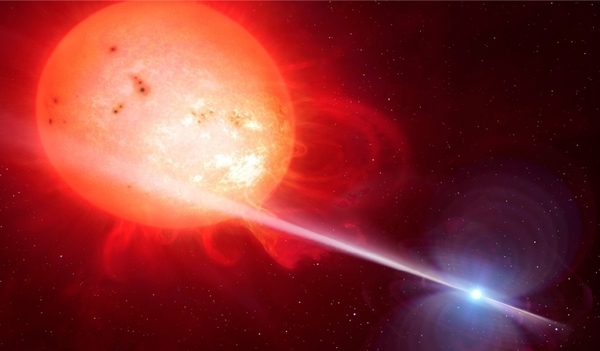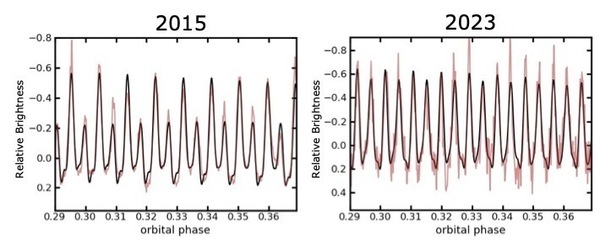The white-dwarf system AR Scorpii (AR Sco), which consists of a cool, dim star interacting with a rapidly spinning, highly magnetic white dwarf, has been an object of fascination for University of Notre Dame Physics Professor Peter Garnavich since the announcement of its discovery in 2016.

The first binary star pulsar astronomers discovered, AR Sco is unique because all previous pulsars documented were neutron stars. And during just nine years — a microscopic period of time for the field of astrophysics — Garnavich and collaborators, including researcher and undergraduate physics student Anousha Greiveldinger, have already noticed a variation in the pulses of light from the system. The discovery, published in the Astrophysical Journal Letters, could indicate that the white dwarf’s rotational axis is rapidly changing, a process called precession.
“It came as kind of a surprise,” Garnavich said about the changes he and his collaborators found. “People had seen some random variability, but when we took some data this summer and started looking at the older data, we saw that it’s been quite a smoothly evolving trend.”
AR Sco is 384 light years away, in the constellation Scorpius. From earth, the flashes of light from AR Sco look like a beacon from a lighthouse. The binary system appears to generate two pulses per rotation, likely from two magnetic poles. The changes Garnavich and Greiveldinger pinpointed have occurred in the amplitude — in this case, the intensity of the light energy — of the primary and secondary pulses. When astronomers first discovered the system, the amplitude of the primary pulse was about twice the strength of the secondary pulse. But by 2023, the light curve showed nearly equal amplitudes from the pulses coming from each magnetic pole (as shown in the figure).
“Precession is something that hasn't been explored much in white dwarfs, so this is exciting,” said Greiveldinger, a senior also majoring in French in addition to physics and astronomy.
Precession is the gradual change in a star’s or planet’s rotational axis over time. For instance, the earth’s tilt is 23.5 degrees, and this obliquity is the reason that we experience seasons as the earth orbits the sun. However the direction of the earth’s tilt makes one cycle about every 24,000 years, with the precession occurring the same way a spinning top wobbles slightly as it spins. In the earth’s case, this occurs because of the forces that the moon and sun have on the earth.

AR Sco’s precession, with its rapidly spinning white dwarf, is much faster. If this is the cause of these changes, Greiveldinger and Garnavich expect the amplitudes will become more equal over the next 10 years, then will become asymmetrical again.
AR Sco was thought to be a solitary star until 2016, when researchers discovered the highly variable flashes of light. A Notre Dame student used a sensitive electronic camera attached to the Krizmanich telescope atop Jordan Hall of Science to take long sets of images in the spring and summer, when the star was visible above the horizon. The student captured the flashes and recorded them, and noted tiny changes in the spin rate of the star.
With this latest discovery, also completed using the Krizmanich telescope, “we think its spin axis is cockeyed to its orbital plane of its binary star, which is producing a torque and causing it to precess,” Garnavich said. “So the beams are changing their direction over that precession cycle, and the pole that was pointed away is slowly being aimed in our direction.”
Because AR Sco barely rises more than 25 degrees above our horizon in the Northern Hemisphere, the team combined their observations with data going back to 2015 from researchers in South Africa, Garnavich said. In the Southern hemisphere, the binary system tracks overhead.

Seeing a change in this system has been exciting for Garnavich because it’s rare that an astronomer will notice such a dramatic difference during a lifetime.
“It certainly is cool, and as it turns out, precession isn’t something that’s often seen in stars,” he said. “It’s mostly that it takes so long, but the narrow beams emitted by this unusual star magnify the impact of changes in the direction of the spin axis.”
Garnavich will continue studying AR Sco with students, because they have already gleaned so much information from it in less than a decade, and yet there is more to learn.
“It’s a star that keeps on giving,” he said, half jokingly.
In addition to Garnavich and Greiveldinger, other researchers include Colin Littlefield, formerly of Notre Dame, as well as researchers from the South African Astronomical Observatory, Cape Town, South Africa, the University of Johannesburg, Johannesburg, South Africa, University of Cape Town, Rondebosch, South Africa, the University of Free State, Bloemfontein, South Africa, and the Bay Area Environmental Research Institute, Moffett Field, California.
Originally published by at science.nd.edu on December 18, 2023.